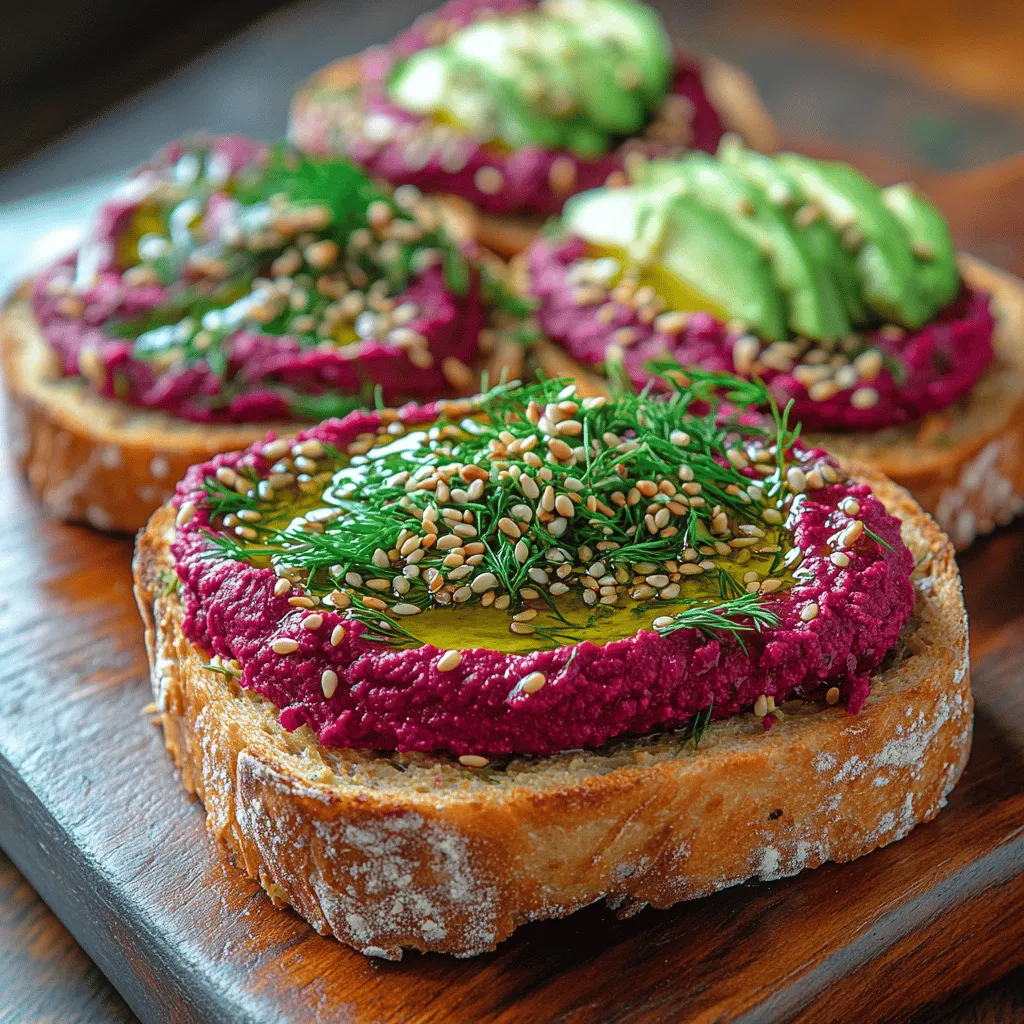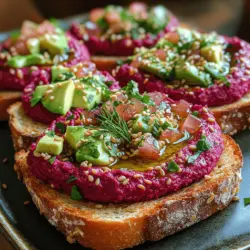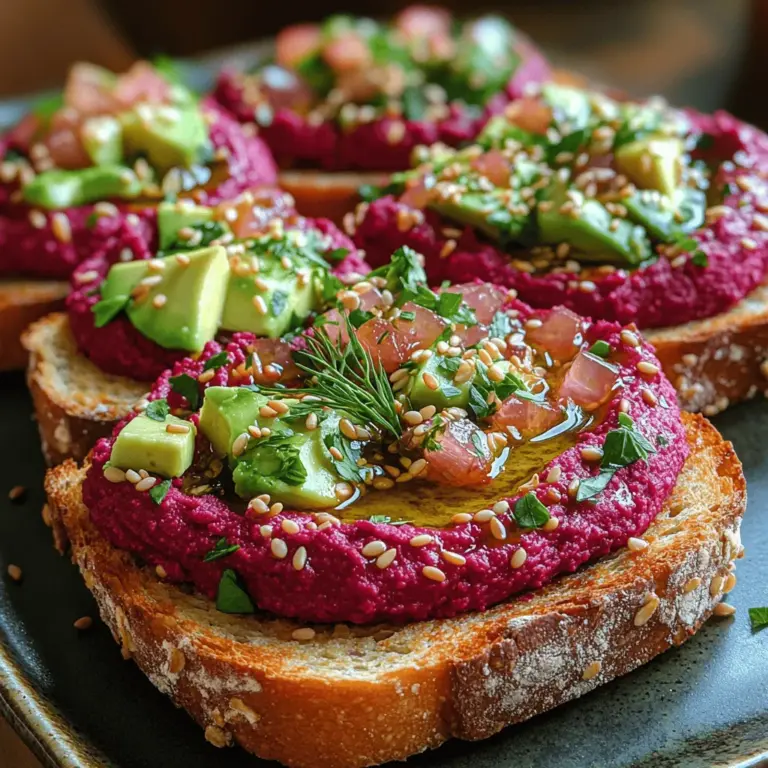Introduction
In the realm of culinary creativity, few recipes capture the imagination quite like Vibrant Beet Hummus Toast. This dish not only tantalizes the taste buds with its earthy sweetness and creamy texture but also dazzles the eye with its striking magenta hue. Beet hummus toast has emerged as a popular choice among health enthusiasts and foodies alike, and for good reason. It serves as a nutritious canvas for an array of toppings, making it versatile enough for breakfast, lunch, or a light snack.
While store-bought hummus can sometimes lack the freshness and vibrancy that homemade versions offer, preparing beet hummus at home allows you to control the ingredients, ensuring that every bite bursts with flavor. Furthermore, the process of making hummus from scratch is not only simple but also deeply satisfying, as you can customize it to your taste preferences.
The flavor profile of beet hummus is a delightful combination of earthy beets, zesty lemon, and creamy tahini, enhanced by a hint of garlic. The unique ingredients work harmoniously to create a spread that is both nutritious and indulgent. In this article, we will explore the essential components of this recipe, guide you through the necessary steps to prepare it, and share tips on how to elevate your beet hummus toast to new culinary heights.
Understanding the Ingredients
Overview of Essential Ingredients
To create the perfect beet hummus toast, you need to gather a few key ingredients that contribute to its vibrant color and flavor. Here’s a brief overview of what you’ll need:
– Beets: The star of the dish, beets not only provide a vivid color but are also packed with nutrients, including vitamins C and B6, magnesium, and iron. Fresh, roasted beets form the creamy base of your hummus.
– Chickpeas: These legumes add a protein punch and contribute to the creamy texture of the hummus. You can use canned or dried chickpeas, but ensure they are thoroughly cooked if using dried.
– Tahini: A staple in Middle Eastern cuisine, tahini is a paste made from ground sesame seeds. It adds richness and depth to the hummus.
– Garlic: Fresh garlic infuses the hummus with a robust flavor. You can adjust the amount based on your preference for garlic intensity.
– Lemon Juice: The acidity of lemon juice brightens the flavors and balances the earthiness of the beets and chickpeas.
– Olive Oil: A drizzle of extra virgin olive oil not only enhances the flavor but also adds a silky texture to the hummus.
– Spices: Cumin and salt are typically used to season the hummus, but you can explore additional spices like smoked paprika or cayenne for an extra kick.
Fresh Produce: Importance of Quality Vegetables
When it comes to preparing beet hummus, the quality of your ingredients is paramount. Fresh, organic beets will yield the best flavor and color. Look for firm beets that are free from blemishes or soft spots. If possible, choose beets that still have their greens attached; this indicates freshness.
You can roast the beets yourself, or if you’re short on time, pre-cooked beets are available in many grocery stores. However, nothing compares to the deep, earthy flavor of freshly roasted beets, which will elevate your hummus.
Protein Choices: Options for Meat, Poultry, or Plant-Based Alternatives
While beet hummus itself is plant-based, you can easily build a balanced meal by adding protein options to your toast. If you’re looking to keep it vegetarian or vegan, consider topping your beet hummus with roasted chickpeas, crumbled feta, or hemp seeds for added protein.
For those who prefer a meatier option, grilled chicken or sliced turkey can be delightful additions. These proteins complement the sweetness of the beets beautifully and create a satisfying, well-rounded meal.
Spices and Herbs: Their Role in Flavor Enhancement
Spices and herbs play a vital role in enhancing the flavor of your beet hummus toast. Aside from the standard cumin and garlic, consider incorporating fresh herbs like parsley or dill for a burst of freshness.
Experimenting with spices such as smoked paprika can add a layer of complexity that contrasts with the sweetness of the beets. Don’t be afraid to taste as you go, adjusting the seasonings until you achieve the perfect balance.
Specialty Ingredients
In addition to the common ingredients, there are several specialty items that can elevate your beet hummus toast. For instance, using high-quality tahini made from raw sesame seeds can significantly improve the flavor and texture of your hummus.
You may also want to explore flavored olive oils, such as garlic or lemon-infused varieties, to further enhance the dish. Specialty markets often carry unique varieties of beets, such as golden or striped beets, which can add an interesting twist to your hummus.
Unique or Regional Ingredients that Elevate the Dish
Incorporating unique ingredients can set your beet hummus toast apart. Consider adding toppings like pickled onions, microgreens, or even a sprinkle of za’atar, a Middle Eastern spice blend, for an aromatic finish. Local farmers’ markets can be a treasure trove for fresh, regional produce that can enhance your dish.
Where to Source These Ingredients for the Best Quality
To ensure that your beet hummus toast is bursting with flavor, sourcing quality ingredients is crucial. Local farmers’ markets are an excellent place to find fresh beets and seasonal produce. Organic grocery stores and health food stores often carry high-quality tahini and olive oils.
If you prefer the convenience of online shopping, many specialty food retailers offer organic and artisanal products that can enhance your cooking experience. Investing in high-quality ingredients not only supports sustainable farming practices but also ensures that your meals are as flavorful as possible.
Preparation Steps
Prepping the Workspace
Before diving into the cooking process, it’s essential to prepare your workspace. A clean and organized kitchen not only speeds up the cooking process but also minimizes errors. Gather all your ingredients and tools before you start, ensuring everything is within reach.
Importance of an Organized Kitchen
An organized kitchen is the backbone of any successful cooking session. Make sure your countertops are clear, and your utensils and equipment are easily accessible. This will allow you to focus on the cooking process without unnecessary distractions.
Necessary Tools and Equipment for the Recipe
To prepare vibrant beet hummus toast, you’ll need the following tools:
– A food processor or blender: This will be your primary tool for blending the hummus to a creamy consistency.
– A cutting board: To chop and prepare your ingredients efficiently.
– A knife: A sharp knife will make cutting through the beets and other vegetables much easier.
– Measuring cups and spoons: For accurate ingredient measurements.
– Baking sheet: If you plan to roast additional toppings, such as chickpeas.
Detailed Ingredient Preparation
Start by preparing your ingredients. If you’re using fresh beets, you’ll need to wash them thoroughly to remove any dirt. Once clean, trim the tops and bottoms, and wrap each beet in aluminum foil. Place them on a baking sheet and roast them in the oven at 400°F (200°C) for about 45 minutes or until tender.
While the beets are roasting, you can prepare the chickpeas. If you’re using canned chickpeas, drain and rinse them well. For dried chickpeas, soak them overnight and then boil until they are tender.
Chopping Techniques and Tips for Efficiency
When chopping vegetables or herbs, utilize efficient techniques to save time. For instance, when mincing garlic, use the flat side of your knife to crush the clove lightly before chopping. This technique releases the garlic’s natural oils and aroma, making it easier to chop finely.
Marinating or Seasoning Tips for Enhanced Flavor
As you prepare your ingredients, consider marinating the chickpeas in olive oil, lemon juice, and spices. This not only infuses them with flavor but also adds an appealing texture when roasted. If you’re using any fresh herbs, chop them just before serving to preserve their freshness and aromatic qualities.
Cooking Techniques
Overview of Primary Cooking Methods Used in the Recipe
The primary cooking methods for making vibrant beet hummus toast include roasting and blending. Roasting the beets enhances their sweetness and imparts a deeper flavor, while blending creates that smooth, creamy consistency that hummus is known for.
Sautéing: When and How to Sauté for the Best Results
If you choose to add sautéed vegetables as a topping, such as mushrooms or greens, heat a skillet over medium heat with a drizzle of olive oil. Add your vegetables and season with salt and pepper. Sauté until they are tender and slightly caramelized, which will bring out their natural sweetness.
Baking or Roasting: Tips for Achieving Perfect Textures
When roasting beets, it’s important to monitor them closely towards the end of the cooking time. The beets should be fork-tender but not mushy. If you desire a slightly charred flavor, remove the foil during the last 10 minutes of roasting to allow the beets to caramelize.
Alternative Cooking Methods for Dietary Preferences
For those who prefer a quicker method, you can also steam the beets instead of roasting them. Steaming allows the beets to cook through without losing too much moisture. Simply place them in a steamer basket over boiling water until tender.
Timing and Temperature
Timing is crucial when preparing your ingredients. Be mindful of the cooking times for each component. For example, the beets may take about 45 minutes to roast, while chickpeas will only need about 20 minutes if you’re roasting them.
Importance of Cooking Times for Various Ingredients
Different ingredients have different cooking times, and it’s essential to stagger your cooking accordingly. This ensures that everything is ready at the same time and that your vegetables maintain their ideal texture.
How to Test for Doneness and Adjust Cooking Times
To test the doneness of your beets, insert a fork into the center. If it slides in easily, they are ready. For chickpeas, taste one to ensure it’s tender but not mushy. Adjust cooking times based on your oven’s performance, as different ovens can vary in temperature accuracy.
—
This detailed exploration of Vibrant Beet Hummus Toast sets the stage for a culinary experience that is not only colorful and delicious but also healthful. As we continue with the next part of the article, we will dive deeper into the flavor development and presentation tips to make your beet hummus toast truly unforgettable.

The Science Behind Flavor Layering
Flavor layering is an essential culinary technique that enhances the complexity and richness of any dish, including our vibrant beet hummus toast. Understanding how to build and balance flavors can transform simple ingredients into a gastronomic delight. The process begins with aromatics—ingredients like garlic, onion, and herbs—that lay the foundation for flavor.
In our beet hummus toast, the garlic complements the earthiness of the beets, while lemon juice adds brightness. Layering these flavors allows each element to shine and interact harmoniously, creating a more satisfying taste experience. As you progress through the cooking process, focus on incorporating ingredients in a sequence that maximizes their flavor potential.
Balancing Flavors
Achieving a well-balanced dish requires a careful consideration of the four core flavor profiles: sweet, salty, sour, and umami. For the beet hummus toast, the sweetness of roasted beets pairs beautifully with the tanginess of lemon juice, while tahini introduces a nutty, creamy umami quality. A touch of salt enhances these flavors, making them pop.
To balance these flavors effectively:
– Sweetness can be adjusted by the amount of beet used and the addition of a drizzle of honey or maple syrup.
– Saltiness can be controlled with the type of salt used or by adding feta cheese as a topping.
– Sourness can be fine-tuned with fresh citrus juice or a splash of vinegar.
– Umami is naturally present in tahini and can be amplified with nutritional yeast or miso paste.
Incorporating Sauces and Garnishes
Sauces and garnishes play a crucial role in elevating the overall taste and presentation of your beet hummus toast. A signature sauce can tie all the elements together, adding an extra dimension of flavor. To create a simple yet memorable sauce, consider blending tahini with lemon juice, a pinch of salt, garlic powder, and a splash of water to achieve the desired consistency. This creamy sauce will enhance the richness of the hummus and bring a zesty kick.
Garnishing the toast is where creativity shines. Here are some ideas:
– Herbs: Fresh dill, parsley, or cilantro add a burst of freshness.
– Seeds: Sprinkle sesame seeds or pumpkin seeds for crunch.
– Microgreens: A handful of microgreens can elevate the presentation and add a peppery flavor.
– Edible flowers: These can make your dish visually stunning and add a subtle taste.
Serving Suggestions
To truly enjoy your beet hummus toast, consider the following serving suggestions that will enhance your meal experience:
Ideal Pairings
Pair your beet hummus toast with a variety of toppings and accompaniments. Some ideal pairings include:
– Avocado slices: Creamy avocado adds richness and healthy fats.
– Roasted vegetables: Carrots, zucchini, or peppers can add texture and flavor.
– Cheese: A sprinkle of feta or goat cheese can provide a tangy contrast.
Side Dishes
Complement your toast with light side dishes that balance the meal. Consider:
– A fresh arugula salad dressed with lemon vinaigrette.
– Roasted chickpeas for added protein and crunch.
– A light soup, such as a tomato basil or carrot ginger blend.
Beverage Pairings
Enhance your dining experience with carefully chosen beverages. Suggestions include:
– A crisp white wine (like Sauvignon Blanc) that complements the earthiness of beets.
– Herbal teas, such as chamomile or mint, which can cleanse the palate.
– Sparkling water with a splash of lemon for a refreshing non-alcoholic option.
Presentation Tips
Visual appeal is key to any culinary experience. Here are some presentation tips to make your beet hummus toast stand out:
– Plating Techniques: Use a large, flat plate to allow the toast to breathe. Arrange the toast in the center and sprinkle garnishes around it to create a colorful palette.
– Serving Style: Consider serving the toast on a wooden board for a rustic touch, or individually plated for a more formal dining experience.
Nutritional Benefits
The vibrant beet hummus toast is not only delicious but also packed with nutritional benefits. Here’s a closer look at the health properties of its key ingredients:
Overview of Health Benefits
– Beets: Rich in antioxidants, vitamins, and minerals, beets are known for their anti-inflammatory properties and ability to support heart health.
– Chickpeas: A great source of plant-based protein and fiber, chickpeas promote digestive health and help stabilize blood sugar levels.
– Tahini: Made from ground sesame seeds, tahini is packed with healthy fats, calcium, and magnesium, contributing to bone health and heart function.
– Fresh Vegetables: The addition of fresh vegetables and herbs not only enhances flavor but also boosts the dish’s nutrient density.
Dietary Considerations
This dish is naturally gluten-free and vegan, making it accessible for various dietary preferences. It fits well into a balanced diet, providing healthy fats, proteins, and carbohydrates, making it an excellent choice for a light lunch or snack.
Meal Planning Ideas
Incorporating beet hummus toast into your meal planning is easy. Prepare extra beet hummus in advance and store it in the refrigerator for quick meals throughout the week. Pair it with different toppings each day to keep things interesting.
Storage and Reheating
To ensure that your beet hummus toast remains fresh and tasty, follow these best practices for storage and reheating:
Storing Leftovers
– Best Practices: If you have leftover beet hummus, store it in an airtight container in the refrigerator. It typically lasts for up to one week.
– Recommended Containers: Glass containers are excellent for storage as they do not absorb odors and allow for easy visibility of contents.
Shelf Life of Ingredients
– Hummus: Homemade beet hummus can last for about 5-7 days in the fridge. If you notice any separation or an off smell, it’s best to discard it.
– Bread: The toast can be stored at room temperature for a day or two, but for longer storage, keep it in the freezer.
Reheating Methods
– Optimal Methods: To reheat the toast, place it in a toaster or oven until warmed through. Avoid microwaving, as this can lead to a soggy texture.
– Quality Tips: If using a toaster oven, check frequently to prevent over-browning.
Conclusion
Vibrant beet hummus toast is a delightful dish that combines nutrition, flavor, and visual appeal. Its versatility makes it suitable for various occasions, whether as a light lunch, snack, or appetizer. Not only does it cater to diverse dietary needs, but it also encourages creativity in the kitchen through toppings and presentations.
Cooking and sharing this homemade meal can bring joy to your dining table, fostering connections with family and friends. Embrace the art of cooking, experiment with flavors, and let your beet hummus toast shine as a centerpiece of your culinary repertoire. With its appealing colors and delicious taste, this dish is sure to impress anyone fortunate enough to enjoy it.

